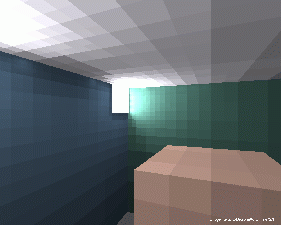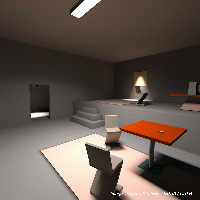Radiosity et participating media
My PhD thesis (defended in October 1994, in French) has “Hierarchical Radiosity and Radiative Transfer in Participating Media“ for title. Kadi Bouatouch (IRISA, Rennes, France) was my advisor. The main domain is about realistic image synthesis obtained via applications of physical laws.
There are two parts in this thesis. The first is about a hierarchical radiosity technique based on an adaptive recursive patches subdivision using a test on reciprocal form factors computed with the help of ray casting through a hemisphere.
As pseudo-photons (carrying form factors element) were drop on surfaces, we introduced the shadow particle (“shadowon” or “ombron in French”) which is dropped on the next intersected surface along the ray. This helped to distinguish low lit surface from surface with shadow parts.
The second part of the thesis was about fumes, fog and clouds in a image synthesis context. We implemented a modified discrete ordinates method which we connected to the radiosity part. Therefore, energy exchanges between clouds and objects were considered.
Essential collaborations during this thesis: Pierre Tellier for the radiosity part and Michael Chelle for participating media.

Radiosity and patches
Above is a picture showing the patch adaptive subdivision (shown not interpolated for explanation). We made the 3D scene composed of a cubic room, with a floating cube in the center. Then, we add two square lights to the left wall (only one of them is fully visible). We designed this scene because, at that time, it was particularly difficult to render such a scene using a uniform sampling radiosity method. Smaller patches are visible close to the source lights.
The image under shows a more complicated scene (with a zig-zag chair). Light evolution is visible on the roof.

